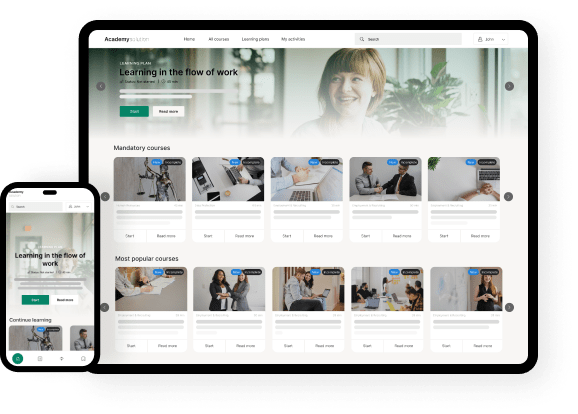Do you know what companies with successful digital transformation projects have in common? It isn’t artificial intelligence, augmented reality, or any other new technology.
Surely, these technologies at present time can drive your digital transformation program. But they aren’t enough to sustain it for a longer time. Why? Because digital transformation isn’t always about using the best tech or replacing legacy systems.
And that’s exactly what we’ll emphasize in this blog post.
We’ll tell you why a significant number of digital transformation projects fail and only a few actually thrive. And let’s give you a hint: It has something to do with how organizations approach digital transformation.
So, if you’re struggling to get over the early humps of your transformation plan, this post is for you. Let us help you dig yourself out of that paralyzing predicament. To begin, we’ll answer the most undervalued question: What is digital transformation?
Digital transformation as a sustainable innovation
Digital transformation is a way of reimagining business functions and human experiences with digital technology as the backbone. It helps you reinvent and give new meaning to how you do business.
This innovative approach is holistic because it covers all aspects of your enterprise. It also transcends traditional processes such as employee onboarding, product and process development, and customer service.
In a nutshell, digital transformation is any effort that creates new value to what is important in your organization. This business model doesn’t replicate processes. It rather reinvents them to develop more sustainable and revolutionary solutions.
When we say sustainable and revolutionary, we’re referring to qualities that help future-proof your business. And to future-proof your project means to avoid transformation fatigue.
Avoid fatigue in digital transformation
In a highly volatile environment such as the digital market, organizations can experience change or transformation fatigue.
Transformation fatigue occurs due to constant disruptions in workflows and technology learning curves. Such force and momentum can produce worn-out teams, frustrated L&D managers, and disengaged clients.
If your digital transformation efforts focus on quantity rather than quality, you can easily succumb to this kind of fatigue.
So, instead of jumping on the transformation bandwagon, you should first establish a solid foundation by asking these questions:
- What issues or problems are we trying to solve?
- Can our existing processes or technologies help manage these issues?
- If our current technologies aren’t faring well anymore, is there anything we can still keep or improve?
- How can we implement changes without causing too much disruption?
- How can we sustain our solutions?
To get the best answers, you need to take a step backward.
How to approach digital transformation
In his published article in Forbes, Greg Kihlstrom, a best-selling author, and entrepreneur, had this to say about digital transformation:
A great digital transformation project is designed with a deep understanding of the current processes, why (for better or worse) they exist, and the problems that they solve. Only by having a good understanding of the current state of things can we design something better.
Kihlstrom suggests that digital transformation begins and ends with your existing processes and the issues they address. And improving current business functions through digital transformation requires a simple act of retrospection — a step backward.
A fundamental philosophy applied in Amazon’s successful digital transformation journey also has something to do with stepping or working backward.
During an interview, Jonathan Allen, Enterprise Strategist at Amazon Web Services explained that working backward means starting with the customer’s problem and behavior—the human element of any digital transformation program. Here’s what he said:
…every new innovation starts with a customer problem. The team then works backward, using available data on customer behavior, to identify the best solution. This is opposed to the more usual idea of starting with the idea for a new product or service and then trying to find customers who might want to buy it.
According to Allen, this approach starts with sample press releases. These press releases are then used to gather ideas from the public. With the collected feedback, Amazon begins a new solution or project based on actual, useful consumer data.
Amazon uses such information as a template to improve customer experience. If you’ve ever visited the tech company’s website, you probably noticed how they use artificial intelligence to influence customers’ buying behavior. All product suggestions on their website are based on shopping preferences, past engagements, or demographics.
Consumer data is the most significant element in Amazon’s disruptive innovation. But it isn’t just simple data — it’s real-time data.
Using real-time data in digital transformation

Source: Business Wire
This acceleration is caused by the continuous evolution of digital technology and increased real-time data usage. Yet, companies nowadays face the challenge of managing relentless changes brought by these accelerators.
However, with a massive task at hand, some tend to zero in on the acquisition of technology, which leaves real-time data in the shadows. It then forces one’s transformation project to proceed with a blind eye, lacking a clear purview of the digital market.
What is real-time data?
Real-time data is active, instantaneous, and uninterrupted data. Such records include information about your:

Having real-time data and knowing how to utilize it helps your business avoid making bad decisions. With resilient and available data, your digital transformation program possesses a set of functioning optics to monitor changes in the digital market and analyze consumer behavior.
In an age where businesses need to stay on top of trends and make intelligent decisions, real-time data can be a significant asset.
Netflix, for example, uses real-time logs from playback devices to understand and quantify how users’ devices are handling browsing and playback. Once data is gathered, they feed them into a database:
Every measure is tagged with anonymized details about the kind of device being used, for example, whether the device is a Smart TV, iPad, or an Android Phone.
Ben Sykes, Senior Software Engineer at Netflix
This approach allows Netflix to classify devices and view data according to various aspects. As a result, the company is able to isolate issues only related to a particular group, types of devices, or specific countries.
For Netflix, it was about picking the correct data and pushing innovative technology updates without disrupting user experience. This was only possible because of the availability of aggregated data that is continuously checked and measured.
Conclusion
You now know that a digital transformation process isn’t as simple as going paperless or automating essential business functions.
It’s about discovering new ways to look at your business and the services you provide. And your transformation journey isn’t a guaranteed success. You might encounter challenges along the way, including transformation fatigue.
Transformation fatigue can be a major roadblock to the success of your digital transformation program. And to get over this barrier, you must build your transformation program around a strong foundation by working backward — viewing things from all possible angles using real-time data.
Real-time data is any reliable data about your customers, competitors, and market trends. Using such information enables you to create realistic solutions in a drumbeat and initiate groundbreaking changes without causing much disruption to your value chains.
Start your digital transformation project with Cursum
What better way to kick off your transformation project than to turn your know-how into an academy.
If you’re a domain expert who runs a brick-and-mortar consultancy business, scaling your services can be challenging. Unless you productize your knowledge and turn it into an online academy, growing your business and reaching more customers should be easier.
Cursum offers you an opportunity to shift from a dormant offline business to an innovative online enterprise. This process begins by productizing your expertise into an all-in-one digital solution.
Not only will you create an additional revenue stream, but you’ll also develop a future-proof business that’s both scalable and sustainable. Who knows? Your ideas might be the next “big thing” in this age of innovative disruptions.
Book a demo now and learn how your company can make a difference!


